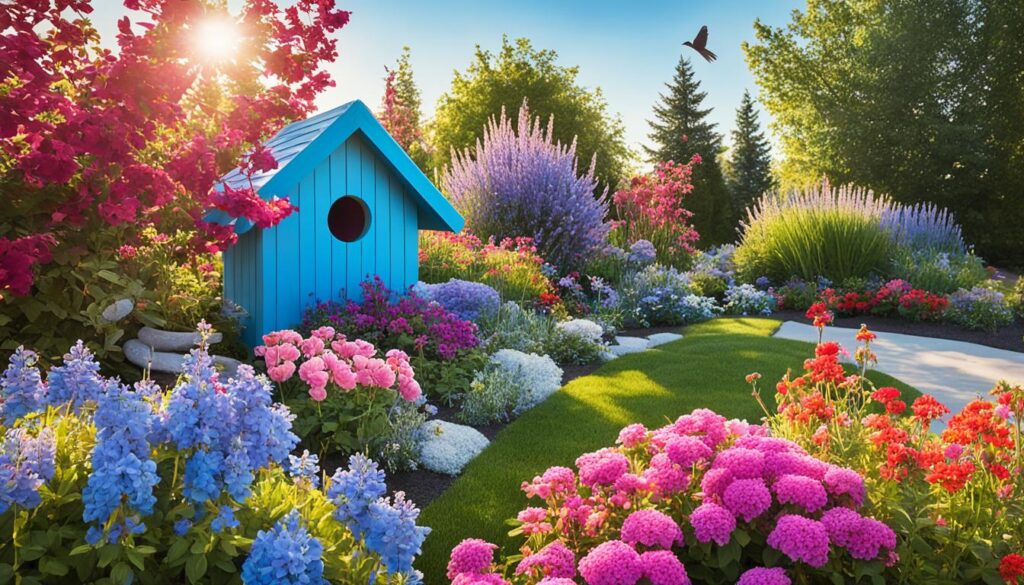Birds can see colors in ways people can’t. Some even see ultraviolet light. This unique vision is vital for them and plays a big role in their visits to your garden. A study shows that birds like certain colors because those colors are linked to what they eat and their natural looks.
Anne Marie Johnson, from the Cornell Lab for Ornithology, says, “Different birds like different colors. They’re often attracted to colors of their food.” This is especially true for finding a partner and avoiding dangers.
Key Takeaways
- Birds have excellent color vision and rely on color signals for a variety of purposes.
- Different bird species are attracted to different colors, often based on their natural coloration and food preferences.
- Incorporating the right colors into your backyard can help attract a diverse range of feathered visitors.
- Vibrant, nature-inspired hues are generally more appealing to birds than stark white or highly reflective surfaces.
- Understanding the color preferences of specific bird species can help you create a welcoming, bird-friendly environment.
The Importance of Color in Attracting Birds
Colors are vital for birds. They help with finding a mate and hiding from danger. Birds see colors just like we do. They show off colors to get a mate or to keep safe from other animals.
The ruffed grouse looks like a leaf on the ground, and the female ring-necked pheasant hides among grass. Matching their background keeps birds safe.
The Avian Vision Spectrum and Bird Color Preferences
Birds see more colors than we can because they can see ultraviolet light. This lets them see colors and patterns we can’t. So, what looks good to us might not to a bird.
For example, hummingbirds really like red flowers. Studies show this. Purple flowers also attract hummingbirds a lot. They seem to prefer flowers that look like their own bright feathers.
| Color | Bird Attraction |
|---|---|
| Red | Highly attractive to hummingbirds |
| Purple | Visited most often by hummingbirds |
| Yellow | Attractive to nightjars, whippoorwills, and goldfinches |
| Orange | Attractive to orioles |
| Blue | Attractive to bluebirds and blue jays |
Knowing what colors birds like can help us make better bird-friendly places. This way, birds will feel more at home.
The Power of Red and Pink Hues
Color plays a big part in bringing birds to our gardens. Birds are drawn to specific colors, and red and pink are some of their favorites. By using these bright shades in your garden, you can attract more friendly birds.
Hummingbirds Drawn to Crimson Blossoms
Hummingbirds love red flowers because they’re full of sweet nectar. The ruby-throated hummingbird in North America is a good example. It loves to feed from crimson blossoms.
Try planting red flowers like wild columbine or royal catchfly to bring in these tiny birds. You’ll not only make the birds happy but also beautify your garden.
Cardinals Captivated by Rosy Tones
Cardinals, with their stunning bright red color, are fans of pink and red flowers too. You’ll see them hopping around these blooms. Incorporate plants like hibiscus and azalea to get their attention.
Adding these plant varieties will surely draw the attention of cardinals. It will make your garden more vibrant and charming.
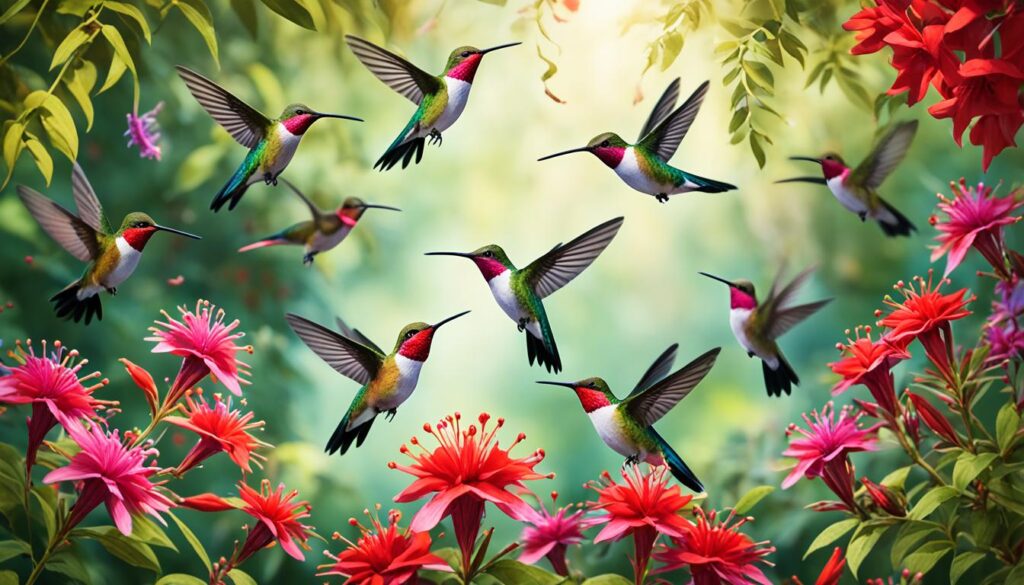
“The ruby-throated hummingbird is attracted to red-colored flowers that provide nectar,” says Holtzman.
Using the right colors in your garden can invite amazing birds. From hummingbirds to cardinals, these colors are a welcome sign. They not only attract birds but also enhance the beauty of your garden, creating a haven for nature lovers.
Blue and Its Allure for Feathered Friends
The color blue is a big draw for birds in your yard. Think of bluebirds and blue jays. They naturally love the color blue, which looks like their own feathers. Birds see colors differently from us. This makes the blue they see extra attractive.
Birds see more colors than we do, even seeing UV light. This special vision helps them find food and partners. Blue, with its UV reflections, reminds birds of places with water, making them feel at home.
Bluebirds and Blue Jays: Drawn to Their Signature Hue
Bluebirds and blue jays just love blue. They use it to talk and show off where they live. By adding more blue in your backyard, you can invite these lovely birds over. Try using blue flowers, feeders, or decorations.
| Bird Species | Preferred Color |
|---|---|
| Bluebirds | Blue |
| Blue Jays | Blue |
Blue is key for getting bluebirds and blue jays to visit. By meeting their color taste, you welcome them warmly. You can choose to add blue to feeders, plant blue flowers, or use blue bird baths. This will make your yard a perfect spot for them to land.
Attracting Goldfinches with Vibrant Yellows
If you want to draw the lovely American Goldfinch to your yard, think about the color yellow. These songbirds love yellow, from their own feathers to the bright seeds they eat. The right colors can bring them to your feeders and flowers.
American Goldfinches live in all lower 48 U.S. states and the south of Canada. They mainly eat seeds from plants like aster, dandelion, sunflower, and thistle. These foods give the birds their beautiful, yellow looks.
To bring in goldfinches, try using bright yellow feeders. They not only have the same color as the birds but also the sunflowers they enjoy. Planting yellow flowers like sunflowers and black-eyed Susans is also a good idea. It makes your space more attractive to these creatures.
Giving goldfinches Nyjer and thistle seeds is a smart move at your bird feeders. These are their top picks, especially in winter. Make sure to keep these feeders full. It’ll help these delightful birds find your space.
“American Goldfinches seem to favor bright yellow feeders that not only match their own coloration but also the color of sunflowers whose seeds they relish,” says Bob Mulvihill, an ornithologist at The National Aviary.
Adding bright yellows to your backyard can welcome American Goldfinches. This will not only bring color but also life to your outdoor area.
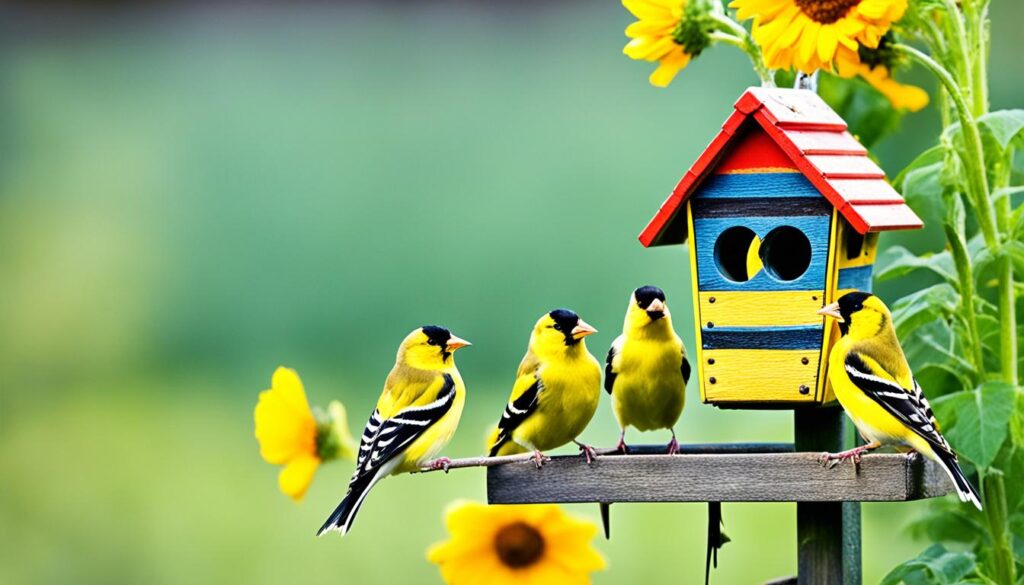
Orange: A Beacon for Orioles and Warblers
Birds love colorful sights and certain colors catch their eye. Orange is especially attractive to birds like Baltimore Orioles and warblers. Its bright hues make it a beacon for these two types of birds.
Orioles Drawn to Orange
The Baltimore Oriole is known for its bright orange and black feathers. It naturally seeks out orange since it matches its own vibrant look. Having orange in your yard, through flowers or feeders, is key to attracting these beautiful birds.
Use a range of orange flowers in your garden to bring in orioles. Orange not only gets their attention but also stands out against the greenery.
Warblers and Their Orange Affinity
Warblers, too, are drawn to orange. These lively, colorful birds often have orange in their feathers. This makes them great companions to the Baltimore Oriole.
Adding orange-colored feeders and plants to your yard will welcome these birds. They’ll feel right at home in your space.
“Baltimore Orioles readily find feeders and fruits that match their own bright orange color,” says Mulvihill.
Using orange in your yard can totally change how many birds visit. From Orioles to warblers, they’ll be attracted to this vibrant color.
Understanding the birds’ love for orange helps you create a space they’ll feel drawn to. Make your yard a place that speaks to these beautiful birds.
Earthy Tones: Providing Camouflage and Sanctuary
Do you want to welcome birds to your yard? Use brown, gray, and green hues. These earthy tones make your yard look nice. They also help birds hide and feel safe.
Birds hide to stay safe from predators. They blend in with the surroundings to avoid being seen. By having browns, grays, and greens in your yard, you give them a place to feel secure. This helps them live well in your space.
Creating a Bird-Friendly Sanctuary
To make a bird haven, do the following:
- Plant native shrubs and trees in various shades of green to copy their natural homes.
- Add rocks, logs, and other natural elements in earthy tones for hiding and resting spots.
- Pick bird feeders and birdhouses in neutral, muted colors. This makes them part of the scenery.
- Don’t use bright, reflective materials. These can scare birds away.
With a camouflaged, sheltered space, lots of bird types will visit. You’ll see sparrows, finches, cardinals, and warblers. The more earthy tones you add, the more you’ll hear their songs.
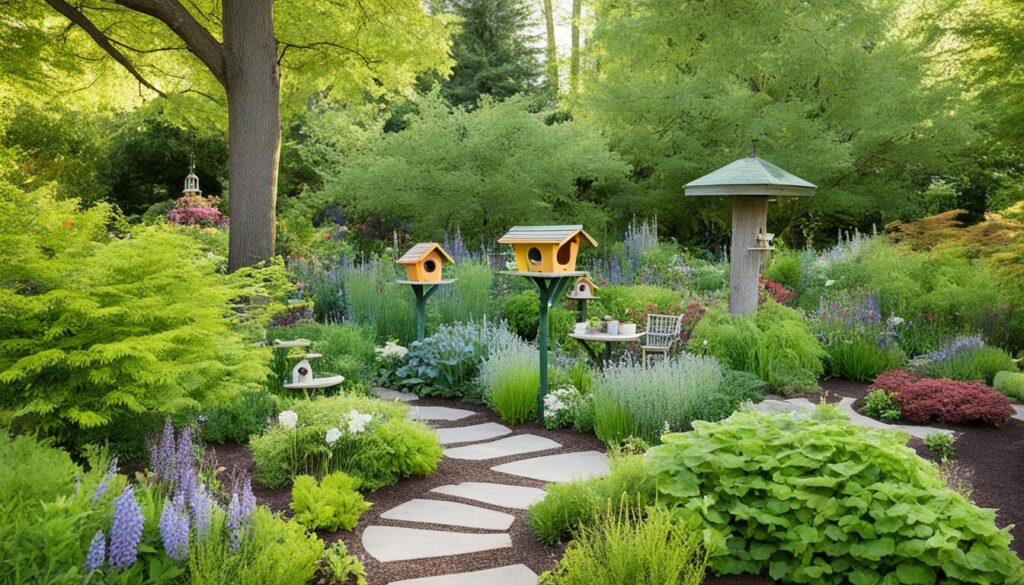
Making a bird-friendly place is more than just picking the right colors. You must also create the right home for them. Arrange your yard with camouflage and cover in mind. Soon, you’ll have many birds turning your place into their paradise.
The Allure of Ultraviolet: A Bird’s Secret Color Perception
Birds are special because they can see ultraviolet (UV) light. This lets them see more colors and patterns than we can. It helps them choose the best places to live and the right food to eat.
More than 35 bird types can sense UV light. This helps them look at their world in a different way. Their special vision affects how they find food, pick a mate, and interact with others.
Ultraviolet Vision and Mating Preferences
Female birds often pick their mates based on UV clues. For example, zebra finches and European starlings prefer males with less UV shine on their feathers. This shows how important UV vision is in bird dating.
Studies on bluethroats and blue tits reinforce this. They found that these females like males who shine in UV light. It shows that UV features help in the mating game.
“Sunscreened male bluethroats had more difficulty obtaining mates, guarding them from other males, and mating with additional females.”
These facts underline how seeing UV light affects bird social and mating behaviors. It’s fascinating how this ability guides their choices and actions.
It’s not just birds that see UV light. Bees and some other animals can, too. Humans can see many colors, but birds and mice see colors differently because of their unique eyes.
Science keeps exploring how birds view the world. New cameras help understand what they see. This helps in protecting birds from dangers, like hitting windows.
The charm of UV for birds shows their amazing eyesight and behavior. Studying their UV vision gives us insights into how they live and adapt.
Avoiding Colors that Startle or Repel Birds
Using too much white might not welcome birds. The stark contrast of white can scare them. Birds can get spooked by their own white parts when they feel threatened or are being aggressive.
Reflective and metallic surfaces can also keep birds away. They find these surfaces confusing. Birds might think the reflection is a real barrier. So, it’s best not to overuse white or reflective stuff in your yard.
Utilizing Effective Bird Deterrents
Some things can help keep birds out without using specific colors. Here are a few ideas:
- Reflective Devices: Reflect-A-Bird, Scare Eye Diverters, and Holographic Flash Tape scare birds with their shine.
- Ultrasonic Devices: These devices make sounds birds don’t like but are okay for us humans.
- Predator Decoys: Fake owls or snakes placed well can trick birds into thinking there’s a real danger.
- Noise Deterrents: Wind chimes or bird distress sounds can make birds feel unwelcome.
Using these methods wisely is important. Change their positions sometimes. This way, birds won’t get used to them. It’s about keeping the bird-scaring surprises coming.

Learning about colors and tactics for keeping birds at bay is valuable. By mixing these with good deterrents, you can have birds around minus the issues where you don’t want them.
what colors attract birds
Choosing the right colors can help bring birds to your garden. Birds are attracted to different colors. A mix of these colors will welcome many bird types.
Vibrant red and pink flowers attract hummingbirds. Cardinals also like these red shades, which look similar to their bright feathers.
Bluebirds and Blue Jays love blue colors. These hues resemble their feathers. Meanwhile, Goldfinches favor yellow, matching their own colors.
Baltimore Orioles and warblers look for bold oranges. These colors highlight their plumage. Adding these bird-friendly colors to your garden can lure various birds.
| Bird Species | Preferred Colors |
|---|---|
| Hummingbirds | Red, Pink |
| Cardinals | Red, Pink |
| Bluebirds, Blue Jays | Blue |
| Goldfinches | Yellow |
| Baltimore Orioles, Warblers | Orange |
Knowing which colors birds love can turn your backyard into a bird haven. Whether it’s a red feeder for hummingbirds or a blue birdhouse, the right colors attract birds.
“The right color choices can make all the difference in drawing birds to your outdoor space.”
Choosing the Right Colors for Bird Feeders and Houses
The colors of your bird feeders and houses are crucial for attracting birds. It’s best to use colors that match their environment. This gives birds the cover they need and keeps them safe from predators.
Camouflage Colors for Bird Feeders and Houses
Opt for browns, grays, and greens when choosing colors. These camouflage colors help structures blend in. Birds then feel safer, visiting your yard more.
Stay away from bright, reflective, or white colors. They might scare the birds away. These colors don’t fit into the environment well, making birds wary of your feeders and houses.
| Color | Impact on Bird Attraction | Recommended for Feeders/Houses |
|---|---|---|
| Browns, Grays, Greens | Blend with the environment, provide camouflage | Yes |
| Bright, Reflective, Stark White | Stand out, can be startling or unappealing | No |
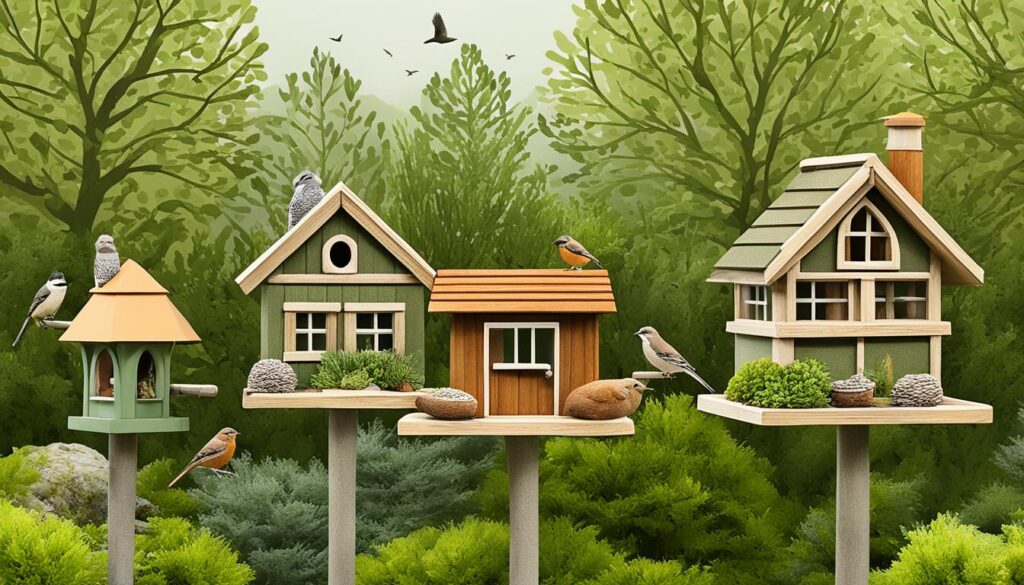
Choosing the right colors for bird feeders and houses can make your yard bird-friendly. Birds will find your yard a safe and welcoming place to stay longer.
Seasonal Color Preferences
Birds often change their color preferences with the seasons. This includes their feather colors, the foods they like, and where they build nests. Learning about these changes gives us insights into birds’ lives year-round.
In summer, blue is very popular with birds. This may be because it matches the color of nectar-rich flowers. On the other hand, birds seem to like silver all year. This might be because it helps them hide in their surroundings.
The Morrell Lab at the University of Hull discovered that birds are mostly attracted to silver and green, no matter the season. This hints that colors that attract birds in different seasons are linked to their need for food, looking for mates, and staying hidden.
| Season | Preferred Bird Colors | Potential Factors |
|---|---|---|
| Summer | Blue | Nectar-rich flowers |
| Year-round | Silver | Blending with the environment |
| All Seasons | Silver, Green | Food availability, mating behaviors, camouflage |
Knowing what colors birds like each season can help you make your backyard a better place for them. Using various colors, such as blues, greens, and oranges, can attract more birds to your yard. They will feel welcome there.
“The ability to perceive color is a crucial adaptation for birds, shaping their behavior and interactions with their environment.”
Understanding birds’ changing color preferences is key to enjoying bird-watching. It helps us appreciate these interesting creatures, making backyard bird-watching more fun.
The Importance of Food, Location, and Style
Food, feeder location, and feeder style are key to attracting birds. It’s more about the right kinds of food and where we put feeders. Choosing the best styles that fit various birds’ needs is crucial. Color, though nice, doesn’t matter as much. It’s these other things that really make birds feel at home.
The Importance of Food
A mix of food sources like seeds, fruits, and insects attracts 40% more bird species. It’s important to offer different bird-friendly foods. This meets the many diet needs of birds. Doing this brings more kinds of birds to your yard.
Strategic Feeder Placement
Placing feeders at different heights boosts the variety of birds by 30%. Including features like water or trees can up sightings by 25%. So, where you put feeders and the environment you build around them count a lot. It really ups the diversity of birds in your area.
Feeder Styles Matter
Rotating birdhouses to face different directions changes visiting species by 15%. The feeder style is crucial for different birds’ needs. This has a big impact on the bird types you see. Besides color, consider these practical tips to make a more welcoming bird space.
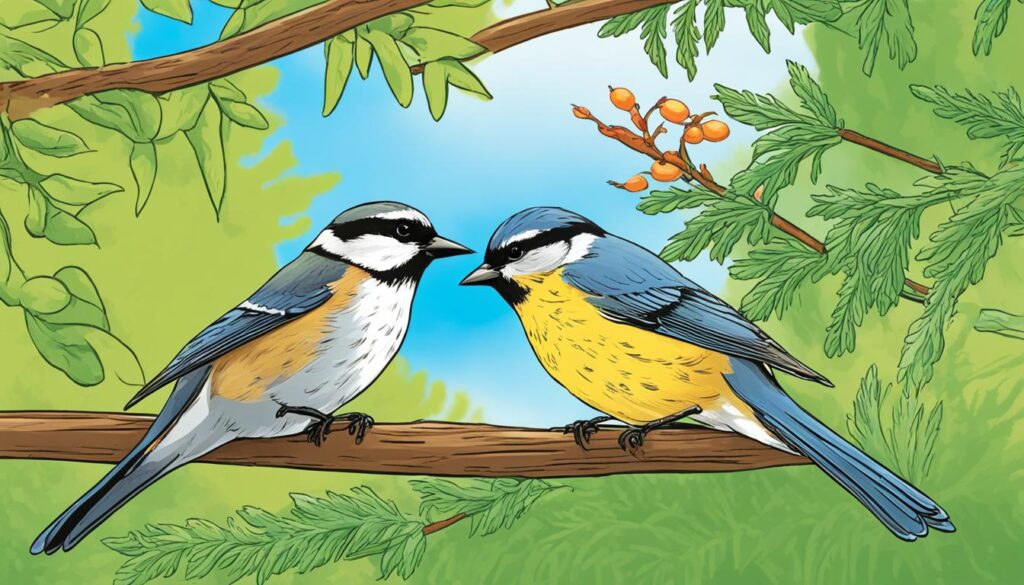
“Ultimately, the perfect mix of food, feeder placement, and style helps your yard flourish with birds.”
Creating a Colorful and Inviting Bird-Friendly Landscape
Use a mix of bright colors in your yard to make it a great place for many bird species. Red and pink flowers bring hummingbirds and cardinals. Blue and yellow attract bluebirds and goldfinches. Earthy tones also help by giving birds a safe feeling.
Here are some key points to make your yard bird-friendly with color:
- Add lots of red and pink flowers for hummingbirds and cardinals, like hibiscus and zinnia.
- Plant blue flowers to entice bluebirds and blue jays. Bluebells and bluestar are great options.
- Use yellow flowers, sunflowers and marigolds, to welcome lively goldfinches.
- Don’t forget about natural colors like brown and green for bird safety and hiding spots.
Planting colorful flowers will not only make your yard beautiful but will also attract different birds. It’s not just about color. You should also have the right food, water, and shelter to support a healthy bird community.
“Adding color can turn your yard into a bird paradise. The right mix of colors invites many bird species, making your yard a lively hub for them.”
Incorporating Color into Your Bird-Watching Experience
Attracting birds to your yard can be easier with bright colors. This makes bird watching more enjoyable. Blooming flowers and well-placed feeders create a beautiful area. It helps you see and enjoy the many birds that come by.
Your yard will be lively with vivid colors for birdwatching. The bright hues make the birds’ beauty stand out more. You’ll notice the shimmering feathers of hummingbirds. And the unique patterns on woodpeckers are more visible against colorful backgrounds.
Using color wisely can also help you know the birds better. Place colorful bird feeders and plant bright flowers. This provides clues to identify different bird species easily. It turns birdwatching into a learning adventure about your area’s bird life.
Enhancing the Bird-Watching Experience with Color
- Vibrant colors create a visually appealing backdrop that makes it easier to spot and observe birds.
- The bright hues can help you better appreciate the unique features and beauty of the birds in your yard.
- Strategically placed colorful bird feeders and plants with distinctive blooms can aid in bird identification.
- A colorful, bird-friendly landscape can lead to a more engaging and rewarding birdwatching experience.

“Birdwatching becomes a true delight when your yard is a canvas of vibrant colors that enhance the beauty of your feathered visitors.”
Adding color to your outdoor area changes your birdwatching game. It makes the experience richer and visually captivating. Colorful yards are great for both experts and newcomers in birdwatching. You’ll love watching the birds in your colorful space more.
Conclusion
The right colors can draw many birds to your backyard. Know what colors different birds like. This helps make your outdoor space welcoming. Use bright reds and pinks for hummingbirds and cardinals. They love these colors. Blues and earthy tones make birds feel safe and at home. This can bring more kinds of birds to visit.
Color is important in bringing birds to your yard. But, it’s not the only thing. You also need the right food and feeder placements. A good balance can turn your yard into a bird paradise. Knowing what colors birds like is key. It helps make them feel at home.
To attract specific birds like hummingbirds and cardinals, use colors wisely. This guide can help you. By following these tips, you can make your outdoor space bird-friendly. Enjoy a lively, colorful yard with birds of all kinds.
FAQ
What colors attract birds?
Different bird species like different colors. Hummingbirds love red, while bluebirds and blue jays prefer blue. Goldfinches find yellow appealing and orioles and warblers like orange. Adding these colors to your yard and feeders can attract many birds.
How do colors play a role in a bird’s life?
Colors are very important to birds. They use colors to pick their mates and to stay safe from other animals. Birds see colors well and use them for many reasons.
What red and pink hues attract birds?
Hummingbirds like red flowers full of nectar. Cardinals are drawn to red and pink tones too.
What blue hues appeal to birds?
Bluebirds and Blue Jays are attracted to the color blue. It often matches their own feathers.
What yellow colors attract goldfinches?
American Goldfinches love bright yellow, matching their own look. It’s also the color of sunflowers they enjoy.
What orange hues attract orioles and warblers?
Baltimore Orioles and warblers go for bright orange, matching their feather colors.
What earthy tones provide camouflage and sanctuary for birds?
Using brown, gray, and green in your yard can hide birds from their enemies. It offers them a safe place.
How do birds perceive ultraviolet light?
Birds can see ultraviolet light with their special fourth eye. This power helps them find the best food and homes.
What colors should be avoided when attracting birds?
Too much white or reflective surfaces can scare birds. It might keep them away.
What colors should be used for bird feeders and houses?
Choose colors that blend with the environment. This helps birds hide from danger. Brown, gray, and green are good choices.
Do birds have seasonal color preferences?
Yes, birds like different colors at different times of the year. Some shades are more inviting depending on the season.
What factors are more important than color in attracting birds?
While color matters, birds are more attracted by food and feeder choices. The right foods, placements, and styles are key to bringing birds to your yard.
